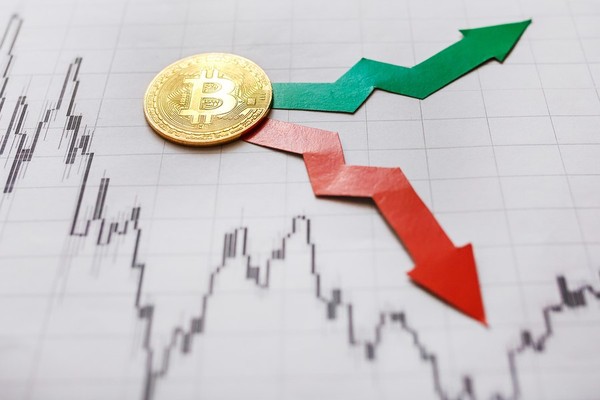Stability Is Coming: What Are the Least Volatile Cryptocurrencies?

Cryptocurrency volatility is a curse and a blessing rolled into one. For adventurous investors, extreme price fluctuations mean an opportunity to gain significant profit. For average cryptocurrency enthusiasts, volatility means unpredictable deals and unexpected losses.
Stablecoins emerged in 2014 as a solution to the volatility problem and have since made an impact on the cryptocurrency market. Let’s discuss how stablecoins keep their prices level, what opportunities they offer, and their short- and long-term implications for the financial market. But first, let’s examine Bitcoin a little closer.
Is Bitcoin the Most Volatile Cryptocurrency?
Despite being notoriously volatile, Bitcoin has seen a stable price trend in recent months. In September 2019, its 30-day volatility reached a ۴-month low. Although the coins have been traded between $10,000 and $11,000 in August, the price fluctuations were rather moderate compared to previous spikes. Additionally, Bitcoin’s monthly range dropped to a 25% difference for the second month in a row, reaching its minimum since March 2019.
The decreased volatility and lower trading volumes may seem like a positive trend that heralds the cryptocurrency maturity. However, many investors consider it the calm before the storm. Bitcoin has been stuck in the consolidation phase that needs to end to drive the price up and attract new investors.
According to Bitcoin Market Journal, Nano was the most volatile cryptocurrency of 2018 with the highest one-year price variance at 8.95%. Metaverse ETP, Waltonchain, and Verge were not far behind, all showing the yearly price variance above 8%. The same report had Bitcoin at only 3.73%.
What Are the Most Stable Cryptocurrencies?
Unlike Bitcoin and altcoins, stablecoins are designed with the minimum price volatility in mind.
Tether (USDT), one of the early stablecoins, was developed in 2014 as a response to the problem of cryptocurrency price fluctuations. The tokens are asset-backed and pegged to the US dollar, meaning one coin is worth $1. Over the years, Tether has become one of the most traded cryptocurrencies in the world with its trade volume reaching 60% of Bitcoin.
Questionable legal procedures and asset transparency aside, Tether remains the most stable cryptocurrency on the market. Tether is traded across 50 exchanges. Its daily standard deviation is generally below 0.5%. Its market cap exceeds $4.1 billion, and it makes up 98% of daily stablecoin trading volume. Despite the developers’ best efforts, the USDT volatility still depends vastly on the coin’s daily trading volume, and the general cryptocurrency market volatility.
Other stablecoins with daily standard deviations below one percent include USD Coin, Paxos Standard Token, Gemini Dollar, NUSD, and TrueUSD. DAI and CKUSD are also among the least volatile cryptocurrencies with daily deviations between 1 and 1.5 percent.
Two of the stablecoins, Paxos Standard Token and Gemini Dollar, have learned from Tether’s mistakes and tried to make their asset-based structure as transparent and secure as possible. Both tokens enjoy the approval of New York regulators. The dollars used to purchase these cryptocurrencies are held in accounts or trusts that are regularly audited by the financial services department. This adds another layer of protection to the tokens and keeps their prices stable.
While authorities do not regulate TrueUSD and USD Coin, both ensure price stability and token security by other means. The former relies on a network of third-party trusts to handle the assets backing the cryptocurrency. The latter is managed by a group of companies that share responsibilities and secure the assets.
According to The State of Stablecoins report, the number of stablecoins under development increased dramatically in 2018. While asset-based tokens are dominating the market (77%), most algorithmic stablecoins are stuck in the development stage. 54% of the coins rely on crypto-asset backing, while the rest use off-chain collateral, including fiat currencies, real estate (SwissRealCoin), and gold (HelloGold).
Algorithmic stablecoins are digital-native solutions that rely on software code to regulate the price automatically without using collateral. The algorithmic central authority can control the currency volume to drive the price up or down and keep it at the same level in the long term.
However, the algorithmic stablecoins have yet to make an impact, as none has made it to the market. For instance, Basecoin was a promising concept that had success at the pre-sale stage. However, regulatory hurdles resulted in the suspended development process earlier this year. The team returned the funds and put the official launch on hold.
Are Stablecoins the Ultimate Anti-Volatility Solution?
Despite the excitement surrounding both asset-based and algorithmic coins, the technology remains imperfect and requires further research and innovation to achieve the Holy Grail of cryptocurrency.
The current market conditions allow for up to ten significant stablecoins to be in use in the near future. However, existing stablecoins are not in direct competition with Bitcoin and altcoins, so they serve a complementary function. For instance, stablecoins can be used as a medium of exchange for the coins that are difficult to trade for fiat currencies. They can also serve as an acceptable store-of-value medium for long-term low-risk investors.
In the long term, stablecoins can have a significant impact on the cryptocurrency infrastructure. Experts believe that price stability will be a major driver of mass cryptocurrency adoption. At the same time, stablecoins can come into competition with fiat currencies and traditional financial assets, which may lead to a new round of regulatory backlash. The international and regional governing bodies that haven’t paid much attention to cryptocurrency adoption may develop new regulations to prevent the uncontrolled use of tokens.
While Bitcoin is far from the most volatile cryptocurrency on the market, it can’t compete with stablecoins when it comes to price stability. Tether, TrueUSD, and USD Coin are all popular and time-proven asset-based coins that are worthy of attention. However, with a few dozen algorithmic cryptocurrencies under development, it’s unclear how long they will remain at the top of the stablecoin market. The ultimate anti-volatility solution remains out of reach for now.



